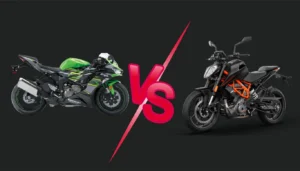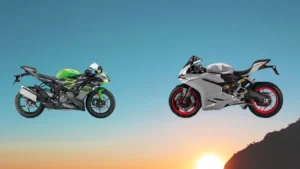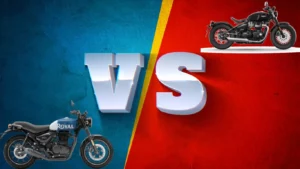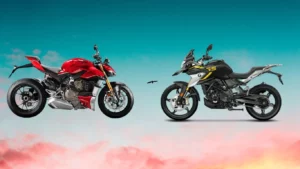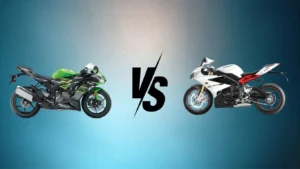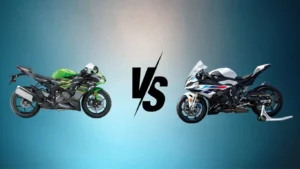If you’re a motorcycle enthusiast, chances are you’re familiar with the Kawasaki Ninja ZX-6R and the MV Agusta F3 675. These two formidable machines have established themselves prominently in the European motorcycling market, there are plenty of reasons cyclists are enthusiastic about them.
Yet, how do these two impressive examples of craftsmanship stack up against each other? We’ll delve into aspects like their performance, design, and popularity, giving you a comprehensive comparison that can strengthen your understanding. So buckle up, as we contrast and critique these two powerhouses of the motorbike world.
Unveiling the Rivals: Kawasaki Ninja ZX-6R and MV Agusta F3 675
Let’s dive right into the deep end of the motorbike world, with two giants of the industry under our scrutiny; the Kawasaki Ninja ZX-6R and the MV Agusta F3 675. These two beasts are renowned for their stellar performances, captivating designs, and unrivaled popularity. But when put to the test, which one tips the scale in its favor? Let’s delve into the world of speed, design, and market preference in the European market.
A Tale Of Two Beasts
No comparison would be complete without a thorough understanding of the contenders. The Kawasaki Ninja ZX-6R, with its distinct racing lineage, is revered for its poise and prowess. On the other side, we have the MV Agusta F3 675, a machine renowned for its sleek design and matchless performance. Drawing from Italian aesthetics and an undeniable racing pedigree, it truly holds its ground in this head-to-head battle.
An Intense Rivalry
The battle lines are drawn, and the stage set with the Kawasaki Ninja ZX-6R and MV Agusta F3 675 taking centre stage. Each motorcycle shines in its own right, a testament to the years of development and innovation from their respective manufacturers. However, when placed side by side, intriguing similarities and stark contrasts emerge, painting a vivid picture of two industry leaders pitted against each other in a tussle for dominance.
The Judgment Criteria
Our comparison will span across several factors: performance, design, engine specifications, agility on the track, popularity, comfort for the rider, chassis construction, price, safety features, fuel efficiency, history and heritage, European preference, durability, and customer satisfaction. By evaluating these two marvels of engineering through a multi-faceted prism, we aim to provide an unbiased assessment that will help you choose your metal steed wisely.
Are You Ready?
So, buckle up and get ready for an immersive journey as we dissect these marvels of engineering. As we cut through the noise and marketing jargon, we are set to dwell into the real essence of these machines. By the end of our tour, you’ll have a crystal clear vision of the Kawasaki Ninja ZX-6R and MV Agusta F3 675 both in isolation and in relation to each other.
Slicing Through the Wind: The Aerodynamic Design of MV Agusta F3 675
Shaped to dominate the wind, the MV Agusta F3 675’s design effortlessly embodies the timeless allure of aerodynamic efficiency. With every line and curve carefully crafted, it holds the power to turn heads and command the road with grace and speed. Its design not only captivates but also contributes significantly towards achieving this machine’s impressive performance metrics.
Born to Rule the Wind
The MV Agusta F3 675’s design is both a marvel of engineering and a work of art. Its slender, compact dimensions are supplemented by an ultra-lightweight structure, skillfully designed to enhance aerodynamics. The bike’s bodywork appears fused with the wind, illustrating its keen focus on maintaining a fluid profile for higher speed and greater maneuverability.
The Aerodynamic Advantage
The aerodynamic efficiency of the MV Agusta F3 675 extends beyond mere aesthetics. It has a tangible impact on the bike’s performance, aiding in reducing drag and increasing downforce. This leads to improved stability at high speeds and better cornering ability, enriching the riding experience while also boosting racing performance.
Seamless Curvatures and Details
MV Agusta’s commitment to aerodynamic excellence is evident in the smallest details of the F3 675. Sleek, seamless curvatures blend with sharp lines to create a sporty, aggressive stance. This bike isn’t simply designed to look fast – it’s designed to be fast, effortlessly slicing through the wind and delivering superb performance on track or an adventurous ride down open roads.
Pushing the Boundaries: Performance Analysis of Kawasaki Ninja ZX-6R
When it comes to performance, Kawasaki’s Ninja ZX-6R exceeds expectations. This Japanese beast embodies the ideal combination of speed, power, and agility. Its impressive specs have caused a stir in the market, drawing attention to its steadfast performance on both racetracks and public roads. Let’s delve into the particulars of what makes this bike a performance behemoth.
Redefining Speed: The Kawasaki Ninja’s Powertrain
This bike features a powerful 636cc, liquid-cooled, 4-stroke inline-4 engine, which provides ample power for highway riding and racing alike. Its broad range of power, from low RPM to high RPM, maintains a constant, stable speed, even during long-distance rides.
Agility on the Go: Handling and Suspension
Boasting an adjustable suspension, the Kawasaki Ninja ZX-6R offers agility at its finest. The balance between its Showa Big Piston Front Fork and rear mono-shock absorber allows for smooth and precise movement on varied terrains. Meanwhile, its lightweight aluminium chassis delivers nimble handling, supporting sharp turns with flawless precision.
Embracing Technology: Advanced Rider Supports
Kawasaki adopts the latest technological advancements on the Ninja ZX-6R to optimize rider experience. Its KTRC (Kawasaki Traction Control) includes three modes for different driving conditions, while its power mode selection allows riders to control the throttle response, tailoring the ride quality according to individual needs.
Unleashing Dynamism: Quick Acceleration and Braking
The Ninja ZX-6R exhibits exhilarating acceleration, courtesy of its high-performance engine and effective power-to-weight distribution. The presence of powerful breaks, coupled with an efficient anti-lock braking system, ensures that the bike can swiftly and safely decelerate, further contributing to the overall performance profile of this motorcycle.
Design Mastery: Exploring the Unique Features of MV Agusta F3 675
When you gaze upon the MV Agusta F3 675, you’re seeing a masterclass in design, a veritable symphony of form and function, stirred together with a hefty dose of pure artistry. From its beautiful, lustrous fairings, to the svelte silhouette, every inch of this bike has been meticulously crafted for both performance and aesthetics. Let’s further delve into its unique features, those that truly set it apart in the saturated market of super sports motorbikes.
Aesthetics To Drool Over
The MV Agusta F3 675 is more than a motorbike, it’s a moving masterpiece. Every curve, edge, and detail speaks of a design team dedicated not just to speed and power, but also to creating something that stirs the soul. The triple exhaust, a signature feature of this model, adds an aggressive edge to the bike’s rear end.
Compact Yet Powerful
Despite its compact dimensions, the MV Agusta F3 675 is far from lacking in mechanical potency. The compact, lightweight, and structurally efficient design allows for improved agility and control while having negligible effect on the power output.
Innovative Cockpit Design
The rider’s cockpit in this bike is something to behold. Refined in every detail, the setup firmly places the rider at the centre of the design. A TFT screen presents the rider with essential information neatly and efficiently, while the sporty handlebar and chic footrests assure an ergonomic riding experience no matter the duration of your ride.
Unrivaled Aerodynamics
The MV Agusta F3 675 boasts some of the best-in-class aerodynamics thanks to its wind tunnel tested design. The unique zip-like undertail, the aluminum alloy swingarm, and the perfectly balanced chassis – all contribute to the stable and aerodynamically efficient ride, even at high speeds.
Heart of the Beast: Delving into the Engine Specifications of Kawasaki Ninja ZX-6R and MV Agusta F3 675
Power and performance are directly linked to the engine – the very heart of any motorcycle. So, let’s take a deep dive into the heart of these beasts – Kawasaki Ninja ZX-6R and MV Agusta F3 675 – and see just how their engines contribute to their overall performance and output.
Exploring the Powerhouse: The Kawasaki Ninja ZX-6R Engine
The Ninja ZX-6R boasts a 636cc, 4-stroke, 4-cylinder, liquid-cooled engine that delivers a massive horsepower. Paired to a 6-speed transmission with a bi-directional quick-shifter, it accommodates both high-speed and low-speed city rides. Furthermore, the ZX-6R engine is optimized for performance and response – delivering smooth acceleration at all rpm.
The Italian Stallion: MV Agusta F3 675 Engine
The 675cc, 3-cylinder engine that powers the MV Agusta F3 675, on the other hand, is dripping with Italian spirit. The power-packed engine along with a precise 6-speed gearbox offers razor-sharp response and performance at all gears. The engine’s compact design, despite its power, lends to the bike’s nimble handling and aerodynamics, enhancing its rideability.
Critical Analysis: Power to Weight Ratio
Beyond raw power, the crucial aspect of performance lies in the power-to-weight ratio, which paints a clear picture of a bike’s real-world capabilities. The Kawasaki Ninja ZX-6R, with its robust engine and lightweight frame, boasts an impressive power-to-weight ratio, lending to its fast acceleration and agile handling. Meanwhile, the MV Agusta F3 675’s lightweight yet powerful engine ensures excellent power-to-weight ratio, promising thrilling speed and nimble maneuverability.
Efficiency Mapping: Fuel Consumption and Emission
Despite their power-packed performance, both these bikes adhere to strict European emission norms. The Ninja ZX-6R, thanks to its advanced engine technologies, offers decent fuel efficiency despite its power output. The MV Agusta F3 675, not far behind, delivers impressive mileage owing to its efficient engine design and advanced combustion process.
Reliability and Maintenance: The Cost of Power
High-performance engines often come with high maintenance costs. However, the Kawasaki Ninja ZX-6R scores high on reliability with its durable engine requiring less frequent tune-ups, reducing overall maintenance burden. Similarly, the MV Agusta F3 675’s engine, while robust, is designed for durability and ensures less frequent visits to the service station, making it an economical choice in the long run.
Battle of Speed: How the Kawasaki Ninja ZX-6R and MV Agusta F3 675 Compare on the Track
When it comes to top-tier speed performance, the true test is fathoming the prowess of these beasts on the track. The Kawasaki Ninja ZX-6R and MV Agusta F3 675 are renown heavyweights in their class, where bottlenecks are pushed to the brink in the quest for dominance. Let’s compare how these two marvels of engineering fare against one another on the tarmac.
Zero To Hundred: Acceleration Comparison
Acceleration is a fundamental aspect of track performance. The ability to rapidly gain speed can significantly influence a bike’s effectiveness, particularly when considering the start of races or when exiting corners. Here, we weigh the acceleration capabilities of the Kawasaki Ninja ZX-6R against the MV Agusta F3 675.
Track Mastery: Cornering and Handling
On any racetrack, the ability to confidently handle corners is a massive advantage. Both motorcycles are designed to cater to this demand, but they boast different strategies and technologies. It’s time to assess their cornering abilities and gauge how combined technologies contribute to handling and subsequently impacting track times.
Instantly Stopping: Brake Efficiency
Speed is not only about going fast but being able to stop rapidly and safely. Exceptional braking offers you control, which is essential in maintaining momentum and confidence on the track. The Kawasaki Ninja ZX-6R and MV Agusta F3 675 are acclaimed for their brakes, but how do they perform head-to-head?
Final Lap: Track Time Comparison
Ultimately, track performance comes down to one thing – lap times. This culmination of a vehicle’s capacity to accelerate, corner, brake, control, and handle its weight directly influences the time it takes to complete a lap. When the Kawasaki Ninja ZX-6R and MV Agusta F3 675 are pit against each other, which emerges victorious?
Charting Popularity: Kawasaki Ninja ZX-6R vs MV Agusta F3 675 in the European Market
Diving into the realm of motorcycling, we encounter two formidable opponents: the Kawasaki Ninja ZX-6R and the MV Agusta F3 675. Each motorcycle presents a distinct fusion of stellar performance, formidable power, and striking design command the attention of bike aficionados around the globe. However, the fickleness of popularity is a game unto itself and we aim to unravel the standings of these two competitors in the European setting.
Digital Popularity:
Exploring the cyberspace offers us a window into the popularity of these two machines. Considering metrics such as the frequency of brand mentions on blogs, forums, or social media can shed a light on their digital popularity. The Kawasaki Ninja ZX-6R has considerable online visibility, with enthusiasts praising its reliability and performance. On the other hand, the MV Agusta F3 675, spellbinds riders with its unique design, often becoming the topic of conversation on many online platforms.
Market Share:
In evaluating popularity, the actual market share paints a factual picture. How these bikes perform in terms of sales volume will provide a concrete assessment of their standing. While exact figures vary over the years, reports often illustrate the Kawasaki Ninja ZX-6R outranking the MV Agusta F3 675 in sales figures. However, the MV has been making steady progress, increasingly becoming a preferred choice for many European riders.
Fan Clubs and Rallies:
Fan clubs and motorbike rallies offer visceral evidence of the popularity of these bikes. These gatherings showcase allegiance and fervor that go beyond mere statistics. Both Kawasaki and MV Agusta have loyal fan bases in Europe, with clubs and rallies regularly organized in various countries. These events, often featuring parades and races, underline the die-hard loyalty fans have for these two bikes.
Brand Heritage and Influence:
The heritage and influence of a brand play a big role in shaping its popularity. Kawasaki, with its Japanese efficiency and reliability, has carved a niche in Europe. On the other hand, MV Agusta, blending Italian craftsmanship, and performance, has a strong heritage of motor racing that resonates with its European audience.
Riding Comfort: The Rider’s Perspective on Kawasaki Ninja ZX-6R and MV Agusta F3 675
While discussing high-speed performance and agile maneuverability is delightful, it’s equally important to consider the comfort these two super bikes offer their riders. After all, what good is an impressively powerful bike if it leaves the rider sore and fatigued after a brief ride? Let’s compare the comforts offered by the Kawasaki Ninja ZX-6R and MV Agusta F3 675 from the perspective of those who straddle these horses—the riders.
Seat in the Spotlight: Evaluating Comfort and Ride Quality
The Ninja ZX-6R boasts of an ergonomic design that has been updated keeping rider comfort at its heart. The seat is slim and lightweight, designed for optimal comfort while managing to contribute to compact riding position. On the other hand, the MV Agusta F3 675 offers a more aggressive seating position designed for aerodynamic efficiency. Despite the focus on performance, many riders find the balance between comfort and efficiency commendable. The narrowness of the F3’s seat, coupled with just enough padding, has proven to be a hit among many European riders.
Rider Interface: The Reach to the Handlebars and Footpegs
The natural and comfortable reach to the handlebar and controls further dictate the comfort quotient of the ride. The Ninja ZX-6R here ensures ease of reach and an undemanding grip to manage the controls. The footpegs have adjustable positions lending to personal customization of comfort. Conversely, the MV Agusta F3 675’s footpegs are high and rear-set to optimize aerodynamics and cornering clearance. This setup may appear initially sporty and needs some getting used to, but once acclimated, many riders applaud the agile feeling it delivers.
Protection from the Elements: Examining the Windshield and Fairing Design
Protection against the windblast is a major factor that influences the comfort level on long, fast rides. The Ninja ZX-6R features a large windshield that efficiently directs the windblast over the rider, thus reducing fatigue. Its fairing design also provides considerable leg cover, offering respite in colder climates. The MV Agusta F3 675, with its compact, aerodynamic shape, has lesser emphasis on this aspect. The bike is designed for minimal air resistance, and hence, the windshield and fairing are sleek and minimalistic at best, providing only bare minimum comfort against the elements.
The Chassis Showdown: Comparing the Framework of Kawasaki Ninja ZX-6R and MV Agusta F3 675
The chassis, or the framework of a motorcycle, plays a pivotal role in the vehicle’s overall performance and handling. When it comes to the Kawasaki Ninja ZX-6R and the MV Agusta F3 675, both brands have been acknowledged for their distinctive chassis designs. Let’s unfold the details and familiarity we have about each motorcycle’s strong and sturdy framework.
Grasp on Geometry: Balance between Stability and Agility
The Kawasaki Ninja ZX-6R is known for its aluminium perimeter frame, which is designed for high-speed stability without compromising in-city maneuverability. It’s a fine balance, ensuring both dynamic cornering and straight-line stability. The MV Agusta F3 675, on the other hand, adopts a characteristic steel trellis frame linked to aluminium side plates. This design promotes agility, improving the lightweight and competitive nature of the vehicle, especially in tight corners.
Fine Art of Flex: Stiffness and Damping Characteristics
The stiffness and damping criterion of a chassis determine how well a motorcycle absorbs shocks and maintains steadiness. Riding the Kawasaki Ninja ZX-6R feels reassuring and composed, all thanks to its cleverly engineered frame stiffness. Similarly, the MV Agusta F3 675 boasts impeccable damping, which makes for a plusher ride that covers long distances with ease without compromising performance or rider comfort.
Saddle Standpoint: Rider Posture and Seating Position
The frame of the Kawasaki Ninja ZX-6R promotes a more racing oriented seating position which can aid in aggressive riding and track days. However, MV Agusta F3 675 provides a slightly more relaxed seating position, providing added comfort for long rides besides a commendable sporty performance.
Suspending Disbelief: The Suspension Setup
The Kawasaki Ninja ZX-6R employs a fully adjustable Showa BPF (Big Piston Front) fork and a fully adjustable rear shock. These adjustable components deliver improved responsiveness and handling at both ends. On the contrary, the MV Agusta F3 675 features a fully adjustable Marzocchi upside-down fork and a Sachs rear shock, providing superior damping on a variety of road conditions. The handling of both these motorcycles is enhanced by the unique attributes of their respective chassis designs.
Price and Value: Assessing the Cost-Effectiveness of Kawasaki Ninja ZX-6R and MV Agusta F3 675
When it comes to assessing the value of motorcycles like the Kawasaki Ninja ZX-6R and MV Agusta F3 675, the price tag is often just the tip of the iceberg. True value takes into account factors such as performance, durability, cost of maintenance, and resale value, among others. So, let’s plunge into the value assessment of these two remarkable bikes.
Initial Purchase Price
The upfront cost is the first determinant of value. Generally, you’ll find that the Kawasaki Ninja ZX-6R tends to cost less than the MV Agusta F3 675 in most markets. This price difference can influence the buying decision for budget-conscious riders. However, high sticker prices are often justified by premium features and superior performance, which is the case with the MV Agusta F3 675.
Cost of Maintenance and Repairs
A significant element to consider when determining a bike’s value is the costs associated with upkeep and repair. Often, the Kawasaki Ninja ZX-6R is known for its reliability and more affordable maintenance compared to the Italian-made MV Agusta F3 675. However, MV owners often find the higher maintenance cost worth it for the exceptional design and performance the bike offers.
Resale Value
The ability of a motorcycle to retain its value over time contributes significantly to its overall worth. In general, both bikes have great resale values, attributed to their notable brand names and well-respected models. This is another domain in which a higher initial price, such as that of MV Agusta F3 675, can pay off in the long run.
Value-Based on Performance and Features
We must also consider the performance, comfort, speed, design and technological features offering by these two bikes. So, when drawing a parallel on a performance basis, both bikes demonstrate impeccable capabilities. The MV Agusta F3 675 generally offers more premium features, justifying its higher price point.
Rider Safety: Exploring the Safety Features of Kawasaki Ninja ZX-6R and MV Agusta F3 675
When you’re blazing down the highway, the last thing you want to worry about is your safety. Thankfully, both the Kawasaki Ninja ZX-6R and the MV Agusta F3 675 prioritize rider safety without compromising on adrenaline-fueled performance. In our evaluation, we’ll delve deep into the safety features onboard these two machines, assessing the effectiveness of their braking systems, illuminating the benefits of their headlights, and exploring the pros and cons of their integral safety technologies. Equality important in our analysis is the feedback from experienced riders about these two models.
Nailing the Stop: Brakes and ABS
The potency of a motorcycle isn’t truly appreciated without an equally impressive braking system. Both Kawasaki Ninja ZX-6R and MV Agusta F3 675 possess advanced Anti-lock Braking Systems (ABS) for enhanced riding security. These systems prevent wheel lock-up during critical braking scenarios, particularly on slippery surfaces, thus offering greater control to riders.
Guiding Lights: Headlights and Visibility
Visibility on the road isn’t just vital for you as a rider but also for other motorists to see you. Both bikes feature powerful headlights for better visibility at night. Moreover, their distinctive designs make them conspicuous even in dimly lit roads, which greatly improves rider safety.
Invisible Guardians: Integrated Safety Technologies
Modern motorcycles are witnessing a steady integration of technological aids to bolster rider safety. Both Ninja ZX-6R and MV Agusta F3 675 are pioneers in these regards. Offering advanced traction control systems, these superbikes demonstrate a commitment to keep riders safe even when they push these machines to their limit.
Rider’s Verdict: Safety According to the Veterans
Tech specs and features speak volumes about rider safety, but the ultimate assessment lies in the hands of the riders themselves. While most users commend the safety standards of both bikes, some prefer the reassuring heft and stability of the Kawasaki, while the MV Agusta is praised for its nimble responsiveness and stringent safety protocols.
Fuel Efficiency: Kawasaki Ninja ZX-6R vs MV Agusta F3 675
Two-wheel enthusiasts all over Europe have often debated about the fuel efficiency of Kawasaki Ninja ZX-6R and MV Agusta F3 675. Fuel efficiency certainly plays a pivotal role when riders are considering long rides, frequent commutes, or simply for economic reasons. Let’s peel away the layers and examine the gas mileage of these two powerful machines.
The Gas Gulper: Kawasaki Ninja ZX-6R
The ZX-6R, known for its high-speed prowess and robust performance, unfortunately, does not stand tall in fuel efficiency. On average, it delivers approximately 19 kilometers per liter (Km/L), which could be a little disheartening for some. This figure is dependent on riding conditions and can vary, but it’s safe to say that the ZX-6R is not the most fuel-friendly beast on the roads.
The Italian Sipper: MV Agusta F3 675
Turn to the MV Agusta F3 675, and you may breathe a sigh of relief. This Italian masterpiece boasts a better fuel efficiency, averaging 23 Km/L under normal riding conditions. Though it’s not the best in the market, the MV Agusta certainly fares better than the Ninja in terms of gas mileage. Its efficiency is more gentle on the pocket while still delivering an exhilarating riding experience.
Fuel Tank Capacity: A Matter of Range
Another essential aspect to consider when discussing fuel efficiency is the fuel tank capacity. A larger tank might mean fewer trips to the gas station, regardless of fuel consumption. The Kawasaki Ninja ZX-6R has a fuel tank capacity of 17 liters, whereas the MV Agusta F3 675 houses a smaller 16.5-liter tank. The minor difference might not significantly impact your rides, but it’s still a factor worth considering.
Overall Output: Efficiency Meets Performance
When it comes to marrying fuel efficiency with performance, the MV Agusta F3 675 slightly outshines the Kawasaki Ninja ZX-6R. While the Ninja offers unmatched power, the MV Agusta strikes a better balance between fuel economies and the thrill of riding. But remember, your choice depends extensively on what you prioritize more – Is it fuel efficiency, the raw surge of power, or perhaps a balance of both?
Branding and Heritage: The Story Behind Kawasaki Ninja ZX-6R and MV Agusta F3 675
When assessing high-level machines like the Kawasaki Ninja ZX-6R and the MV Agusta F3 675, it’s essential to dive into the roots and legacy of these iconic plantes. The heritage of these brands and the principles on which they were built lay the foundation for the machines they produce today. Let’s take a closer look at the branding and rich history of these two revered motorcycle manufacturers and how it impacts their current offerings.
The Ninja Chronicle: The Kawasaki Legacy
Kawasaki, a household name in the motorcycle industry, kickstarted its journey in the late 19th century in Japan. The journey from building ships to crafting magnificent motorbikes has been a compelling tale of innovation and perseverance. The Ninja ZX-6R, born out of this legacy, is a testament to Kawasaki’s relentless pursuit of design and performance excellence. The Kawasaki ethos, deeply rooted in the Samurai spirit, permeates through the Ninja, empowering riders with unmatched speed and control.
Pure Italian Craftsmanship: The Tale of MV Agusta
On the shores of Lake Varese in Italy, a legend in its own right, MV Agusta, was born. With a deep-seated passion for racing engrained in its DNA, MV Agusta’s creations, including the F3 675, signify an unyielding commitment to performance and design magnificence. The company’s ethos, helmed by the Agusta family, binds elegance, innovation, and speed – the key elements that make MV Agusta a formidable player in the global motorcycle arena.
Branding Brilliance: The Meanings Behind the Insignias
Kawasaki’s logo, featuring its name stylized in a unique typeface and set against a river mark, symbolizes strength, flexibility, and fluidity – characteristics synonymous with the Ninja ZX-6R. On the other hand, MV Agusta’s emblem, featuring a gear and a wing, signifies its dedication to flight-like speed and seamless mechanics, hallmarks that the F3 675 effortlessly embraces.
Heritage Driving Innovation: Unveiling the Bridge
Kawasaki and MV Agusta’s longstanding heritage provides a deep well of inspiration for their modern designs. For Kawasaki, the timeless Samurai spirit inspires the Ninja’s speed and sharp handling, while MV Agusta’s affinity with racing influences the F3 675’s design, fostering an impeccable blend of weight distribution, compactness, and aerodynamics.
The Euro Challenge: Understanding the European Preference between Kawasaki Ninja ZX-6R and MV Agusta F3 675
Choosing between the Kawasaki Ninja ZX-6R and MV Agusta F3 675 in the European market is reminiscent of choosing between equally tantalizing dishes on a gourmet menu. Both motorcycles are impeccable in their own ways, boasting unique engineering, design, and performance. Our goal will be to assess these fantastic machines based on the preferences of European riders. Now, let’s dive deeper to find out which of these motorcycles strikes a cord within the hearts of European motorbike aficionados.
Nod to the Trend: Understanding Europe’s Motorcycle Trend
Motorcycle trends in Europe are influenced by factors such as pricing, utility, design aesthetics, and ease of maintenance. Sportbikes like Kawasaki Ninja ZX-6R and MV Agusta F3 675 are typically held in high regard for their impeccable performance characteristics and arresting visuals. The decision often swings in favor of fuel efficiency, robust after-sales service, and value for money. We’ll analyze how these bikes align with current European trends in subsequent sections.
Riding Preferences: Sport vs Style
European riders display a fondness for both sports and style, differentiating the market from other global regions. The high-speed thrilling ride offered by Kawasaki may attract the adrenaline junkies, while riders seeking a unique amalgamation of power and style might lean towards MV Agusta. The variation in riding preferences throw another intriguing factor into the mix, shaping the motorcycle choice for European riders.
Environmental Consciousness: Green Riders
Europeans are known for their environmental consciousness, and this extends to their choice of motorcycles. How does the fuel efficiency and emission output of these two beasts reflect this? While both bikes are eager performers, their fuel efficiencies and emission ratings can contribute significantly to their acceptability amongst the environmentally conscious European riders.
Variations Across Nations: Does geography play a role?
Europe is a mosaic of cultures and preferences, and what works in one country might not resonate in another. Thus, the choice between the Kawasaki Ninja ZX-6R and MV Agusta F3 675 might differ in Italy, Germany, France, the UK, and other countries. By examining how these bikes perform in different European nations, we may discover geographical preferences shaping the choice of motorcycle.
Longevity and Durability: How Kawasaki Ninja ZX-6R and MV Agusta F3 675 Stand the Test of Time
Unraveling the test of time, the longevity and durability of the Kawasaki Ninja ZX-6R and MV Agusta F3 675 bring to the fore an exceptionally important aspect for riders. How a motorcycle stands up against wear and tear over the years influences a rider’s long-term commitment to a brand. This section delves deep into the resilience and longevity of these two exceptional machines.
Sturdiness in Structure: Built to Last
The Kawasaki Ninja ZX-6R, known for its robust structure, is designed with highly resilient materials that promise durability. Equally intriguing is the MV Agusta F3 675, which has a reputation for being a long-lasting warrior on the roads. Its robust design elements and the use of quality materials contribute to its longevity.
Maintaining Performance: Ageing with Grace?
The true test of a bike’s durability is whether it can maintain its performance over time. The Kawasaki Ninja ZX-6R, despite years of use, continues to impress with its consistent power delivery and handling. In contrast, the MV Agusta F3 675, even after years on the road, still provides an agile ride, leaving people in awe of its capability to age with grace.
Long-term Servicing: The Costs of Upkeeping
When judging longevity, it’s important to explore ongoing service and maintenance costs. The Kawasaki Ninja ZX-6R is often praised for its cost-effective long-term ownership, thanks to less frequent and generally affordable servicing requirements. Comparatively, MV Agusta F3 675, while offering unrivaled Italian design and performance, can sometimes demand a higher toll on maintenance costs.
User Satisfaction Over Time: Consumer Verdicts
Lastly, nothing speaks more to a bike’s resilience than public opinion. Owners of the Kawasaki Ninja ZX-6R frequently praise its durability and longevity in online forums and reviews. Equally, the MV Agusta F3 675 earns adulation over its sturdy build and the ability to maintain top-notch performance over prolonged usage.
Customer Satisfaction: Real User Reviews of Kawasaki Ninja ZX-6R and MV Agusta F3 675
Unveiling the true user experiences of Kawasaki Ninja ZX-6R and MV Agusta F3 675 riders offers a window into real-world performance, comfort, and satisfaction. Relying on the opinions of those who have clocked in hours of ride time on these machines provides valuable insights. Let’s delve into what these riders are saying about their beloved sportbikes.
Handling and Ride Experience: Steering to Satisfaction
Motorcycles aren’t just about speed – they’re about the experience, the thrill of riding. Users of both Kawasaki Ninja ZX-6R and MV Agusta F3 675 often highlight the ease of handling and smooth ride experience. Many riders appreciate the Ninja ZX-6R’s nimbleness and stability, making it a favorite for both city riding and long-distance journeys. On the flip side, the MV Agusta F3 675 enthusiasts exult about the bike’s responsive handling, praising it for delivering sportscar-like performance on two wheels.
Performance and Power: A Tale of Two Speed Demons
When it comes to raw acceleration and speed, both bikes have their fair share of admirers. Ninja ZX-6R owners often touch upon the bike’s stunning power delivery, asserting it can stand toe-to-toe with its competition. Similarly, MV Agusta F3 675 riders are consistently amazed by the bike’s rally-ready acceleration and engine performance, commending the combination of speed and elegance that this race-bred machine offers.
Cost of Ownership: Assessing the Wallet Impact
The initial price tag is the mere start of the story when it comes to so-called super-sports bikes. Maintenance and running costs are a critical part of the equation, and here, opinions diverge. Some riders argue that while the Kawasaki Ninja ZX-6R might be more affordable to buy, the MV Agusta F3 675 holds a slight edge when it comes to long-term cost of ownership, thanks to its lower maintenance costs and fuel-efficiency.
Rider Comfort: Miles with Smiles?
Sportbikes can be tough to ride for extended periods – unless they’re designed with rider comfort in mind. The Ninja ZX-6R is often praised for its comfortable seating and effective wind protection, ensuring riders can clock in mile after mile without fatigue. In contrast, riders of the MV Agusta F3 675 praise its ergonomics and weather protection, pointing out that despite it being a performance machine, MV Agusta has spared no effort in making it a viable long-distance bike.
Final Verdict: Riders Know Best
When it comes down to the wire, many riders note that choosing between the Kawasaki Ninja ZX-6R and MV Agusta F3 675 often hinges on personal preference more than anything else. Both bikes offer impressive performance, strong heritage, and their own unique charm. After all, beauty, as they say, is in the eyes of the beholder – or, in this case, in the rider.

